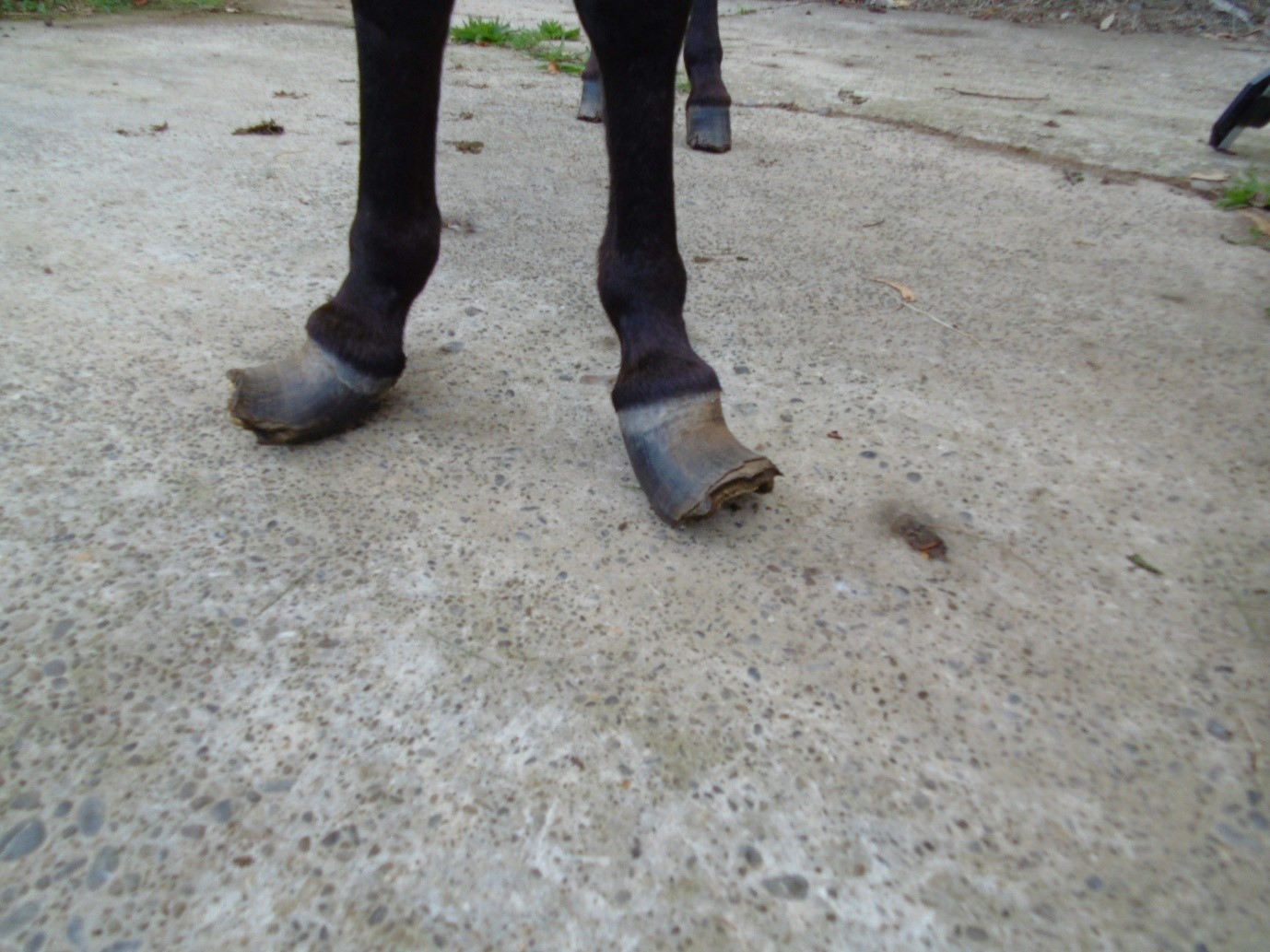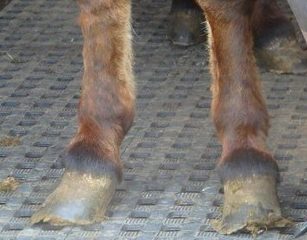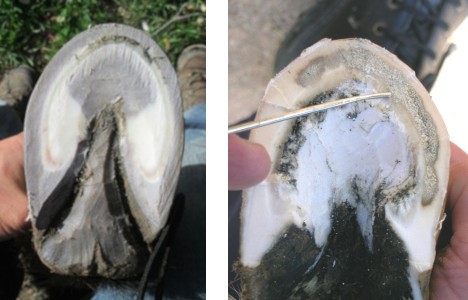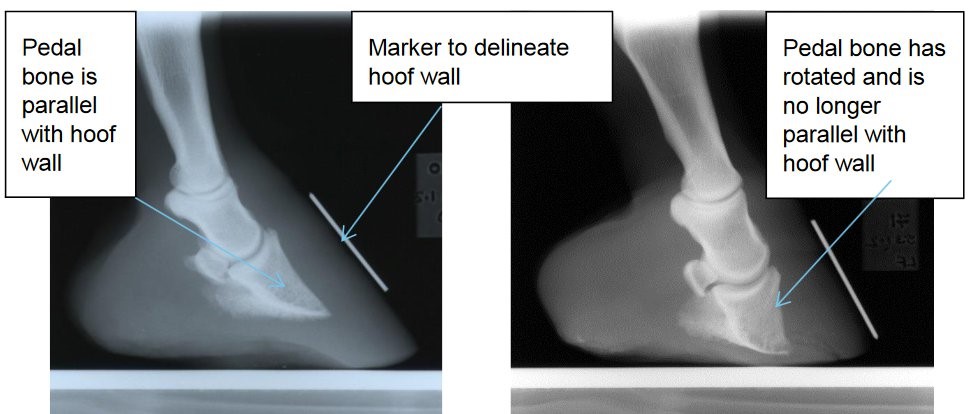Hoof Care
New Zealand is not the ideal environment for the donkey hoof
Hoof Care for New Zealand Donkeys
Hoof care for a donkey is critical if you want to keep your donkeys happy and healthy.
Because donkeys evolved to survive in the harsh dry environment from where they originated, their feet are very different to those of horses’ hooves.
The dry stony terrain of a semi-arid climate is ideal for a donkey and as a result their feet have adapted to be much more efficient at absorbing water than that of their cousin, the horse. This means that when a donkey comes to live on our soft sandy loam, or rich peaty soils that grow lush green moist pasture, their feet can become soft and susceptible to a range of foot diseases. It is of paramount importance that donkeys in New Zealand have the right sort of hoof care for the conditions in which they live.
You may have noticed that many of the donkeys rescued by the Trust often have hoof problems when they come to one of the RRCs. One of the most common issues are over-grown hooves.
All donkeys need their hooves checked regularly and trimmed, typically every 6-10 weeks depending on the terrain where they are kept. This is a job for a farrier or an experienced hoof trimmer like those that run the RRCs.
If you have donkeys or know of people with donkeys, it is worth getting into the habit of checking those donkey hooves before they need work done. Picking out the hoof on a weekly basis helps teach a donkey to lift her leg, gives you a chance to check the hoof for any issues and catch a condition before it becomes too serious.
Donkeys in NZ are susceptible to a number of hoof problems due to our wetter climate and the soft grassy terrain our donkeys are kept on, but if owners are aware of what these conditions are and check their donkeys’ feet regularly then it is possible to prevent most if not all of them. Typical conditions include seedy toe, thrush, laminitis and abscesses.
Here we take a look at each of these and offer some practical advice on how to recognise the symptoms, prevent them from occurring and how to treat the condition should it occur.
A healthy donkey has healthy hooves (photo on the left).
Seedy Toe (White Line Disease)
This is a fungal infection that attacks the white line area of a donkey’s hoof (also called white line disease.) The white line weakens and starts to crumble as the fungus eats its way up the inside of the hoof wall (photo on right above). This condition is usually not painful unless it is left untreated and causes the hoof to become unstable. This can happen as foreign substances like dirt, stones or faecal matter get trapped in the cavity where the hoof wall has crumbled away which can cause the donkey significant pain or worse, get infected. This is why it is so important to check your donkey’s feet on a regular basis.
The best way to treat seedy toe is to catch it before it gets bad and to cut away the infected part of the hoof wall removing all the dead and discoloured matter. This will enable the healthy hoof to regrow, but also may leave a hole in the hoof wall which can easily refill with dirt and debris. One way to fix this is to pack it with a mix of Vaseline, copper sulphate and diatomaceous earth and a small plug of cotton wool and keep the donkey on clean dry ground until the hoof has recovered. Another is to treat the hoof with a solution of copper sulphate inside a hoof boot, this might be a better solution if the ground underfoot is wet or boggy. If the problem persists or gets worse, you need to consult with your farrier or vet who will advise the best course of action.
Thrush
Another condition that can affect a donkey’s hooves is thrush. This is a yeast infection that particularly affects the frog of the foot – that triangular pad at the back of the hoof. You can easily identify thrush from its strong rather unpleasant yeasty smell and it is caused by continued exposure to wet conditions. The best way to prevent this infection is to allow the feet to dry out daily – feeding in a clean dry stall, or on a concrete pad, or regularly walking the donkeys on firm dry ground.
Foot abscess
Sometimes donkeys can get abscesses in their hooves, usually as the result of a wound that penetrates the sole or white line of the hoof. A piece of fencing wire, a shard of glass or a sharp rock, that the donkey unearths when scratching a hole in the dirt to roll, may be all that it takes. An abscess develops when the wound becomes infected and pus builds up. Such wounds can also cause tetanus, a bacterial infection that travels through the blood stream and attacks the nervous system of the donkey. Fortunately there is an effective vaccination protocol in NZ that can protect your donkey from this secondary infection. Ask your vet about it.
If you notice your donkey limping, or behaving differently or you suspect an abscess due to hoof tenderness during one of your regular hoof checks, you need to contact your vet with your suspicions. An abscess is an extremely painful condition and as donkeys are not good at showing pain, it is easy for us to miss the signs unless we are looking for them. Your vet will determine whether or not there is an abscess and may administer a poultice to draw out the infection if it is inside the hoof, or they may cut away the abscess with a hoof knife to drain the infection and then dress it.



Laminitis
One disease all donkeys need to be protected from is laminitis. This is a very painful disease which, should it develop needs immediate veterinary attention and could result in irreversible damage to the donkey’s hoof.
Laminitis can be caused by a wide range of conditions including other underlying metabolic and hormonal disorders (way beyond this article). The best way to protect a donkey is to use a common sense approach, keen observation and give your donkey lots of active engagements.
So what is laminitis?
Essentially what happens is the whole support mechanism for the toe bone within the hoof breaks down causing the toe bone to rotate and move downward causing abnormal hoof growth and a change in the angle of the hoof, making it an extremely painful condition.
If you notice any of these subtle signs of laminitis –contact your vet immediately:- reluctance to turn, a change in behaviour or temperament, reluctance to pick up their feet (particularly if you’ve made this part of their normal routine), an unwillingness to walk particularly on hard or stony ground, lying down more than usual, shifting weight from foot to foot, any abnormal heat at the hoof wall or coronet, and a strong pounding pulse in the blood vessels around the fetlock.
If you suspect your donkey might be showing signs of laminitis:
- call your vet immediately (and farrier/trimmer)
- remove your donkey from any access to grass (if you have to move the donkey some distance, be sure to support the feet before moving)
- confine on deep supportive bedding e.g. sand, sawdust, pea gravel
- support the feet if the bedding isn’t sufficient to do this (e.g. with styrofoam, impression material, or boots). Alternatively you can pad the entire sole using thick cotton wool and bandages.
- If you know how to use them, give NSAIDs e.g. Bute, Danilon, Equioxx for the inflammation & pain (for as short a time as possible)
- apply cold therapy to the feet to reduce inflammation and pain (but not if cold-induced laminitis/feet cold)
- and ensure easy access to food and water until the vet arrives.
X-rays should always be taken whenever you suspect your donkey of having laminitis as many of the signs of chronic laminitis may not be seen until several weeks after the damage has been done and then it will be too late to engage remedial care.
So if in doubt have it checked.
The best way to deal with laminitis is to prevent it in the first place.
10 Ways to Protect against Lamintis
Here are 10 things you can do to protect your donkey as much as possible from getting laminitis or, indeed, any hoof problem:
- Identify whether or not your donkey is “at-risk” by learning as much as possible about their life before they came to you including any previous health history
- Look for signs of hormonal imbalances in your donkey particularly as they age, things like increased thirst or urination, slowness to shed out their winter coat, loss of muscle mass, lethargy or increased infections.
- Ensure any infection your donkey gets is promptly and properly treated
- Limit access to those lush grasses that are rich, starchy and sugary (particularly during the spring and autumn) which can cause a spike in blood sugar levels – as a rule of thumb a donkey should only be exposed to as much grass as they can eat in 20 minutes, and then they should be made to work all day to get it.
- Avoid “sweet” feeds or concentrated foods – donkeys are browsers not grazers so make their food as natural as possible (see our Newsletter No 26 for suggestions).
- Soak “quality” hay prior to feeding – high quality grass hays can have high levels of non-structural carbohydrates (NSC) these are water soluble sugars and simple starches so soaking the hay for an hour prior to feeding can reduce the concentration of the HSCs. Better yet, feed seedy hay or straw which is mainly filler and much better for your donkey.
- Manage their body weight; overweight donkeys are more susceptible to a range of conditions but in particular a heavier body overburdens the donkey’s delicate feet.
- Feed on a routine and make dietary changes slowly. Sudden changes in diet can disrupt intestinal flora, which are the “good” bacteria necessary for effective digestion and a strong immune system. One way to do this is to break up rations into smaller feeds to spread the browsing over the day.
- Make your donkeys walk more – walking increases circulation and stimulates the blood flow to the hoof. Ways you can do this include separating food from water sources forcing your donkeys to walk from one to the other, or taking them for walks on firm surfaces, up and down hills or through interesting bush land where they can have a browse here and there.
- Finally, keep up basic hoof care – checking feet regularly, trimming the hoof properly and maintaining a regular schedule with your farrier
References:
- The Donkey and Mule Society brochure on Hoof Care
- The Donkey Sanctuary https://www.thedonkeysanctuary.org.uk articles on “Donkey Hoof Care”, “White Line Disease”, “Laminitis in Donkeys”, “Feeding Donkeys”, “Tetanus in Donkeys”
- Equus Magazine (equuzmagazine.com) Keys to Preventing Laminitis

